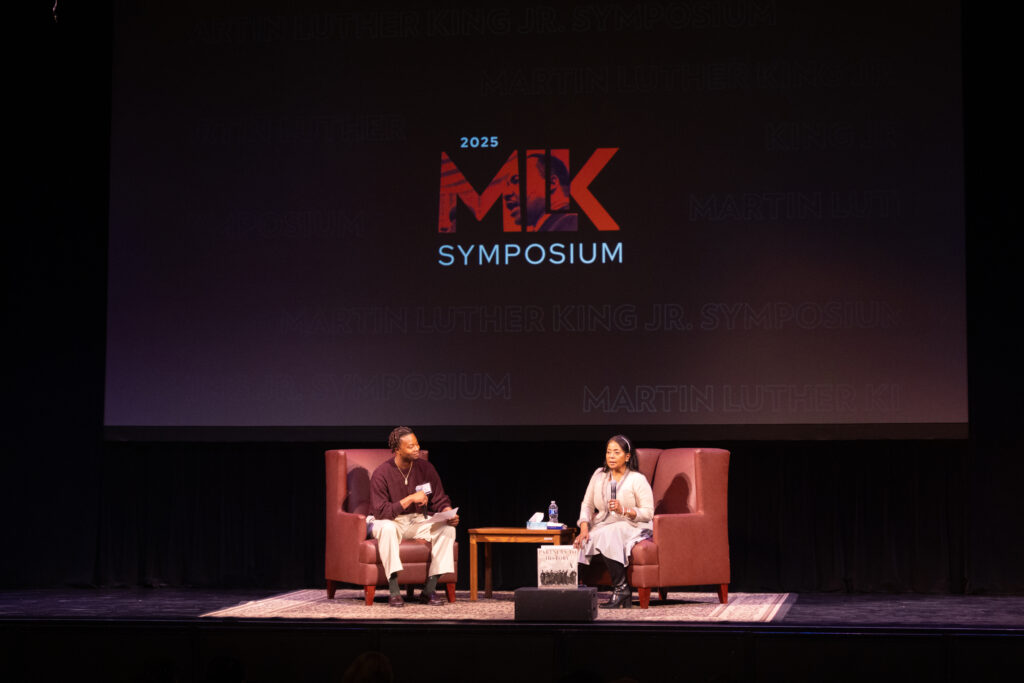Daughter of Civil Rights Leader Rev. Ralph Abernathy, Goddaughter of Dr. King, Brings Unique Perspective to the Making of an Icon; makes plea for continued activism in his name and the others who fought for freedom

The audience in attendance for the 2025 Martin Luther King Jr. Symposium at UW–Madison was treated to an emotional and illuminating experience as they listened to the reminiscences of a woman who called Dr. King “Uncle Martin” as a young child. More than 270 guests were present at Wisconsin Union Theater’s Shannon Hall on January 28th, while nearly 200 were online to hear from the symposium’s keynote speaker, who gave her remarks in the same venue where Dr. King spoke 63 years earlier.
The daughter of Reverend Ralph Abernathy – the renowned co-founder of the civil rights movement and the close friend of Dr. King – Donzaleigh Abernathy had a front-row seat to history, and a view of Dr. King shared by only a few. As Dr. King’s goddaughter, she spent her childhood watching him and her father build the movement, and seeing Dr. King rise from a humble and shy activist into the reluctant leader whom so many revere today.
Presenting a ‘show-and-tell’ unlike any we experienced in elementary school, Abernathy led the audience through an evolution of Dr. King’s and Reverend Abernathy’s leadership in the non-violent fight for civil rights – beginning with their response to Rosa Parks’ arrest in December 1955 for sitting in a section of a bus off limits to Black people – while also displaying snippets of their home life. Photograph after photograph showed the hardships that Dr. King and others endured – the bombings of churches; the burned crosses on their lawns; the segregated schools, hospitals and stores – as well as the struggle to move out of the Jim Crow era that was still so prevalent in the South in the early 1960s.
Organizing petitions, walking the halls of Congress, writing letters, and mobilizing celebrities and others to join their ranks, Dr. King and Reverend Abernathy helped lead an effort that resulted in the signing of the Civil Rights Act by President Lyndon B. Johnson in 1964, as Dr. King stood directly behind the president while the bill was signed.
As a child throughout the 1960s, Abernathy was more than just an observer of the goings-on around her and of the rise of Dr. King. She also was a participant – one might argue even beginning in utero. Her parents’ house was bombed while her mother was five months’ pregnant with her; she was born in a segregated hospital. And she was then among the first African-Americans to integrate an all-white elementary school, which led to constant bullying, including being called the “n” word on a daily basis.
But this experience built and strengthened her resolve. Abernathy came to understand that you can’t meet hate with hate – a theme that she reinforced repeatedly throughout her remarks at Shannon Hall. Bullies suffer from low self-esteem, she said, and she believes that we must teach those who hate to love. She lived that philosophy – later becoming good friends with the daughter of segregationist George Wallace, the one-time governor of Alabama. And she has continued her activism to the current day; in addition to being an accomplished actress, she is an author and playwright, and has served as a board member and volunteer with social justice and educational equity organizations. Her book, “Partners to History: Martin Luther King, Ralph David Abernathy and the Civil Rights Movement,” was nominated as one of the ‘Best Books for Young Adults’ by the American Library Association.
Although her remarks focused mainly on Dr. King, her father, and other Black male activists who advanced the civil rights movement, Abernathy also acknowledged the many others who were key to the movement’s success – including Black women whom she called the “facilitators” of the movement and whose participation was documented by the sea of women’s hats that are visible in the photos she showed of church services and political meetings. Abernathy’s pictorial walk through Dr. King’s rise and the rise of the civil rights movement began and ended with some key messages that she exhorted her audience to take to heart. She continued to hammer home these messages during the Q&A session following the presentation, moderated by a very adept Osose Inegbenoise, a UW–Madison senior and POSSE graduate majoring in computer science with an emphasis on cybersecurity.

She urged younger people in particular to keep the history of the struggle for freedom alive – long after she is gone and not here to provide a first-hand account. “You must tell them,” she implored. She likened this effort to Jewish families who continually tell the story of the horrors of the Holocaust, as fewer and fewer people who lived through that period are still with us. She also made an impassioned case for the importance of education, describing how it was key to success in passing civil rights laws – and how formerly enslaved people, having been denied education for more than 200 years, were hungry for it.
Abernathy also reiterated her plea to meet hate with love, and to embrace diversity and reject making judgements based on the color of one’s skin. After all, she asked, is the blue jay better than the raven?
###
The annual MLK Symposium is co-presented by UW–Madison Student Affairs, the Wisconsin Union Theater and the UW–Madison Division of Diversity, Equity & Educational Achievement to celebrate Dr. King’s legacy and each year features a speaker who reflects upon how his teachings have informed that person’s work or life experience. Read the photo story.